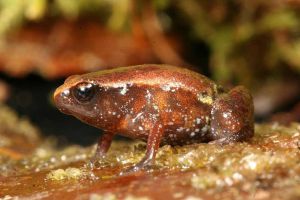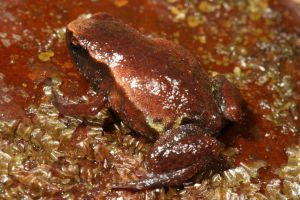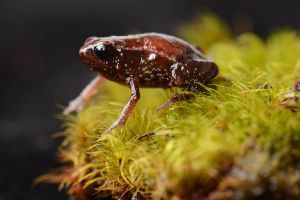
Frogs of Borneo

Frogs of Borneo

Frogs of Borneo

Frogs of Borneo

Frogs of Borneo

Frogs of Borneo

Frogs of Borneo

Frogs of Borneo

Frogs of Borneo

Frogs of Borneo

Frogs of Borneo
dringi
Dring's Sticky Frog
The species was disentangled from Kalophrynus nubicola by Fukuyama et al. 2021. So far, it is only known from the slopes of Gunung Mulu.
It is the smallest species of Kalophrynus, smaller than both K. nubicola and K. puncak. Adult males reach 13.6–15.4 mm in body length; one recorded adult female measured 14.8 mm.
Further morphological features that help distinguish it from the closely related K. nubicola and K. puncak include (highlighted by Fukuyama et al. 2021): the snout is rounded; the third toe is slightly longer than or equal to the fifth toe; the fourth finger projects from the palm less than or equal to the length of the terminal phalanx of the third finger; the tubercles under the fingers are indistinct. A light lateral stripe runs along both sides of the body (absent in K. nubicola and K. puncak). White blotches on the belly and ventral side of the thighs are absent (present in K. nubicola and K. puncak). Distinct yellow and dark inguinal spots are present. Yellow snout patches are absent (present in K. nubicola). The iris is mostly golden to reddish-orange, with black pigmentation in the upper and lower thirds (bluish-grey with black pigmentation in K. nubicola and K. puncak).
The authors also reported some information on the natural history of the species. Specimens of K. dringi are commonly encountered during the day under logs, leaf litter, or mosses in montane mossy forest at elevations of 1290 to 1800 m. Calls were heard only during the day (06:00 to 19:00) in March, August, and December. Kalophrynus dringi is a common anuran species in these habitats, but it is difficult to find due to its secretive nature and preference for hiding under logs, in moss, and in leaf litter.
Version tracking
-
05.05.2025
species added. Images were formerly presented as K. nubicola, now assigned to K. dringi according to Fukuyama et al. 2021.


